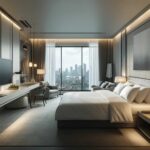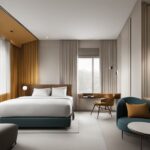A well-planned hotel interior design plays a vital role in guest satisfaction, branding, and overall experience. The right hospitality design elements, from luxury hotel furniture to lighting and décor, influence how comfortable and inviting a hotel feels.
Successful hotel interior design requires thoughtful planning, high-quality materials, and a balance between aesthetics and functionality. Whether designing a boutique hotel, luxury resort, or budget-friendly accommodation, every detail contributes to enhancing guest comfort and maintaining a unique brand identity.
This guide explores key elements of hotel interior design, including furniture selection, space optimization, color schemes, and the role of technology in modern hospitality spaces.
Table of Contents
Toggle- Key Elements of Hotel Interior Design
- Enhancing Comfort and Functionality in Hotel Spaces
- Sustainability and Modern Trends in Hotel Interior Design
- Designing Different Hotel Spaces for Maximum Impact
- The Advantages of Custom Luxury Hotel Furniture
- The Importance of Custom Hotel Furniture in Enhancing Guest Experience
- The Ultimate Guide to Finding Top Hotel Furniture Suppliers in Turkey
- Importance of High Quality Furniture in Hotels
- The Impact of Furniture Design on Hotel Guest Experience
- High Quality Furniture in Hotels: Essential for Guests
- The Role of Furniture in Defining Hotel Aesthetics
- The Evolution of Hotel Furniture Design Over the Years
- How to Choose the Right Upholstery for Hotel Furniture
- The Impact of Furniture Design on Guest Experience in Hotels
- Hotel Furniture and Design: Enhancing the Guest Experience
- Premium Hotel Furniture in Turkey: Elevate Your Hotel’s Interior Design
- How Do Hotels Get Furniture in the Rooms | Hotel Solutions
- Hotel Furniture Concept | Perfect Products for Your Hotel
- Top 5 Benefits of Turkish Made Hotel Furniture
- What makes a good faux leather?
- Furnishing an Apartment: 6 Tips for Choosing the Best Furniture
- Types Of Hotel Furniture You Need
- Why Turkish Made Hotel Furniture is the Best Choice for Your Business
- What is fixed furniture?
- Maximizing Your Hotels ROI with High-Quality Furniture Solutions
- Benefits of Custom Made Furniture
- Hotel Furniture Buying Guide
- Where Do I Buy Hotel Furniture in Turkey?
- How to Make a Hotel Room Feel Like Home
- A good hotel furniture manufacturer
- 7 signs your that hotel needs renovation
- What factors will affect hotel furniture prices?
- Should I Buy Laminate or Veneer Furniture?
- MDF cutting machine
- What are the Basic Furniture Required to Set Up a Hotel?
- What is Crib 5?
- Four Ways to Maintain Hotel Room Storage
- Characteristics of a Custom Hotel Furniture
- Popular Materials for Luxury Hotel Furniture Manufacture
- The Four Characteristics of a Hotel Furniture Design
- 4 Key Considerations for Hotel Furniture
- Hospitality Design Mistakes That Are Common
- Hotel Furniture Quality Control Checklist
- Things Your Hotel Furniture Manufacturer Should Provide
- Why we use 3D Renderings in Furniture Design
- Advantages of Custom Hotel Furniture
- Important Questions to Ask a Potential Hotel Furniture Supplier
- What Are the Guides to Contract Furniture?
- Things to consider when choosing a hotel furniture manufacturer
- Wood Veneers and Laminate Casegoods
- Wooden Furniture Care
- Hotel Furniture Buying Guide
- What Types Of Wood Are The Best For Your Luxury Sofa?
- Hotel Furniture Cushion Upholstery Care
- Leather Furniture Care; Maintaining Your Hotel Furniture
- Ten Tips for Hotel Lobby Design
- Starland Hotel Cameroon
- Hotel Furniture Turkey
- The Best Hotel Furniture Suppliers
- Hotel Furniture Manufacturers in Turkey
- Four Mistakes While Buying a Restaurant Furniture in Turkey 2021
- Selecting Booth and Sofa Seating Made in Turkey
- 10 Restaurant And Cafe Furniture Ideas From Turkey
- Five Most important Materials in Hotel Furniture Industry
- Hotel Renovations: Luxury Hospitality Furnishings made in Turkey
- How to Maintain Hotel Furniture for 10+ Years
- Commercial VS Residential Furniture Made in Turkey
- Hotel Furniture Manufacturing Industry in Turkey
Key Elements of Hotel Interior Design
1. The Role of Hotel Furniture in Interior Design
Furniture is an essential part of hotel interior design, influencing both comfort and aesthetics. Selecting high-quality hotel furniture ensures a welcoming atmosphere while improving functionality.
- Luxury hotel furniture enhances elegance and sophistication.
- Custom hotel furniture allows hotels to create a unique ambiance.
- Multifunctional furniture maximizes space in compact rooms.
Choosing durable, stylish, and well-crafted pieces improves the longevity and appeal of the hotel’s interior.
2. Color Schemes and Their Impact on Guest Experience
Color psychology plays a crucial role in hospitality interior design. The right colors can evoke emotions, create ambiance, and enhance brand identity.
- Neutral tones (beige, white, and gray) create a timeless and elegant look.
- Warm colors (earthy tones, deep reds, and oranges) make spaces feel cozy and inviting.
- Cool tones (blues and greens) promote relaxation and tranquility.
Hotels should use cohesive color schemes that align with their branding and target audience expectations.
Enhancing Comfort and Functionality in Hotel Spaces
3. Smart Space Planning for Optimal Guest Comfort
Space planning is crucial in hotel interior design, ensuring that rooms, lobbies, and common areas are both functional and aesthetically appealing. Effective space utilization includes:
- Open layouts that promote natural movement.
- Efficient storage solutions to reduce clutter.
- Flexible seating arrangements for different guest needs.
Proper space planning enhances the guest experience while maintaining a clean, organized look.
4. Hotel Lighting Design: Setting the Right Mood
Lighting significantly impacts the overall feel of a hotel. A well-lit space improves aesthetics and creates a welcoming environment. Key lighting strategies include:
- Layered lighting, using ambient, task, and accent lighting.
- Warm lighting to create a cozy atmosphere.
- Smart lighting controls that allow guests to customize brightness.
By incorporating modern hotel lighting solutions, hotels can enhance guest satisfaction and energy efficiency.
Sustainability and Modern Trends in Hotel Interior Design
5. Sustainable and Eco-Friendly Hotel Interiors
Sustainability is becoming a major focus in modern hotel interior design. Hotels that adopt eco-friendly furniture and materials appeal to environmentally conscious travelers.
- Sustainable hotel furniture made from responsibly sourced wood.
- Energy-efficient lighting and appliances to reduce energy consumption.
- Recycled materials and non-toxic finishes to improve indoor air quality.
By prioritizing sustainability, hotels can attract eco-conscious guests and improve their brand reputation.
6. The Role of Technology in Modern Hotel Interiors
Smart technology is revolutionizing hotel interior design, making spaces more efficient and guest-friendly. Some popular innovations include:
- Smart thermostats and lighting for personalized guest comfort.
- Touchless check-in systems for a seamless experience.
- AI-powered room service and voice-controlled devices.
Integrating technology improves guest convenience while enhancing the hotel’s modern appeal.
Designing Different Hotel Spaces for Maximum Impact
7. Hotel Lobby Design: Creating a Lasting First Impression
The hotel lobby is the first thing guests see, making it a crucial part of hospitality interior design. A well-designed lobby should:
- Reflect the hotel’s brand identity and theme.
- Offer comfortable seating areas for guests to relax.
- Incorporate art, lighting, and décor to create an inviting atmosphere.
A carefully curated lobby enhances guest perception and sets the tone for their stay.
8. Guest Room Interiors: Comfort and Functionality
Guest rooms should feel like a home away from home. Successful hotel interior design ensures that rooms are:
- Spacious yet cozy, with well-placed furniture.
- Equipped with high-quality bedding and seating.
- Well-lit, with a combination of natural and artificial light.
Personal touches like decorative pillows, artwork, and high-end hotel furniture enhance guest satisfaction and comfort.
9. Restaurant and Dining Area Design
Hotel restaurants should be designed to enhance the dining experience while aligning with the hotel’s overall aesthetic. Important elements include:
- Comfortable seating for long dining experiences.
- Elegant yet functional tables for different group sizes.
- Ambient lighting and décor to set the mood.
By prioritizing comfort and aesthetics, hotels can encourage guests to spend more time in their dining areas.



